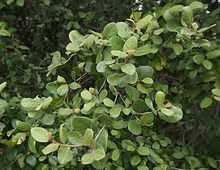Sersalisia sericea
| Sersalisia sericea | |
|---|---|
 | |
| Scientific classification | |
| Kingdom: | Plantae |
| (unranked): | Angiosperms |
| (unranked): | Eudicots |
| (unranked): | Asterids |
| Order: | Ericales |
| Family: | Sapotaceae |
| Genus: | Sersalisia |
| Species: | S. sericea |
| Binomial name | |
| Sersalisia sericea (Aiton) R.Br. | |
| Synonyms | |
|
| |
Sersalisia sericea, also known as Wild Prune, Mangarr, and Mongo is a species of shrubs or small trees, of the plant family Sapotaceae They grow naturally in monsoon forest, littoral rainforest and occasionally in more open forest types across Northern Australia.[1][2]
S. sericea grows to 6 metres tall, although it may produce fruit as a shrub of 1 metre. The plant is characterised by the densely, rusty brown hairs that cover the buds and young leaves. Clusters of small green-white flowers are followed by succulent, dark purple fruit, containing one or occasionally two seeds. The fruit are succulent and edible.[3]
The Kunwinjku people of Western Arnhem Land call the plant and fruit "Mandangnud". As well as being a bush food, the seeds are occasionally used in seed jewellery for sale to tourists in the region.
References
- ↑ "Sersalisia sericea (Aiton) R.Br.". FloraBase. Department of Environment and Conservation, Government of Western Australia.
- ↑ Hyland, B. P. M.; Whiffin, T.; Zich, F. A. et al. (Dec 2010). "Factsheet – Sersalisia sericea". Australian Tropical Rainforest Plants. Edition 6.1, online version [RFK 6.1]. Cairns, Australia: Commonwealth Scientific and Industrial Research Organisation (CSIRO), through its Division of Plant Industry; the Centre for Australian National Biodiversity Research; the Australian Tropical Herbarium, James Cook University. Retrieved 14 May 2013.
- ↑ Simpson, Donald (2011, taken on Nobby Head, Picnic Bay). "Sersalisia sericea". Some Magnetic Island Plants. Retrieved 14 May 2013. Check date values in:
|date=(help)